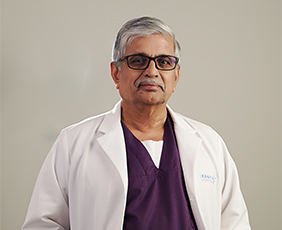IVF treatment steps – you may be wondering how everything will come together. While every fertility clinic’s IVF protocol will be slightly different and IVF treatment are adjusted for a couple’s individual needs, here is a step-by-step breakdown of what generally takes place during an IVF treatment cycle.

Step 1: The IVF cycle before treatment
The cycle before your IVF treatment is scheduled; you may be put on control pills or may then have you start taking a GnRH antagonist or a GnRH agonist. This is so they can have complete control over ovulation once your IVF treatment cycle begins.
Step 2: Periods during IVF treatment
The first official day of your IVF treatment cycle is the day you get your period. (Even though it may feel like you’ve already begun with the medications you’ve started before in step one.) On the second day of your periods, your doctor will likely order blood test and an ultrasound. (Yes, an ultrasound during your periods is not exactly pleasant, but what can you do?) This is referred to as your baseline blood test and your baseline ultrasound.
In your blood test, your doctor will be looking at your hormone levels, specifically your E2. This is to make sure your ovaries are “sleeping,” the intended effect of the shots or GnRH antagonist. The ultrasound is to check the size of your ovaries, and look for ovarian cysts. If there are cysts, your doctor will decide how to deal with them as a part of IVF treatment. Sometimes your doctor will just delay your IVF treatment for a week, as most cysts will resolve on their own with time. In other cases, your doctor may aspirate, or suck, the cyst with a needle. Usually, these tests will be fine. If everything looks OK, IVF treatment moves on to the next step.
Step 3: Ovarian Stimulation and Monitoring as a part of IVF treatment
If your blood test and ultrasound look normal, the next step in the IVF treatment is ovarian stimulation with fertility drugs and its monitoring. Depending on your IVF treatment protocol, this may mean anywhere from one to four shots every day, for about a week to 10 days.
You will probably be a pro at self-injection by now, as and other GnRH agonists are also injectables. Your fertility clinic should teach you how to give yourself the injections, of course, before or when your IVF treatment begins. Some fertility clinics offer classes with tips and instruction. Don’t worry, they won’t just hand you the syringe and hope for the best.
During ovarian stimulation, your doctor will monitor the growth and development of the follicles. At first, this may include blood test every few days, to monitor your hormone levels, and ultrasounds, to monitor the oocyte growth. Monitoring the IVF treatment cycle is important, as it helps your doctor decide whether or not the medications need to be increased or decreased in dosage. Once your largest follicle is 16 to 18mm in size, your fertility clinic will probably want to see you daily.
Step 4: Final Oocyte Maturation in IVF treatment
The next step in your IVF treatment is triggering the oocyte to go through the last stage of maturation, before they can be retrieved. This last growth is triggered with injection. Timing this shot is vital. If it is given too early, the eggs will not have matured enough. If given too late, the eggs may be “too old” and would not fertilize properly. The daily ultrasounds at the end of the last IVF treatment step are meant to time this trigger shot just right. Usually, the injection is given when two or more follicles have grown to be 18 to 20mm in size and your hormone levels are greater than 2,000pg/ML. This shot is typically a one-time injection. The timing of the shot will be based both on your ultrasounds and blood test and when your fertility clinic schedules your retrieval.
Follicles growth and IVF treatment
If not enough follicles grow or if you are at risk for severe ovarian hyper stimulation syndrome (OHSS), your IVF treatment cycle may be canceled and the shot will not be given. If the IVF treatment is canceled because your ovaries didn’t respond well to the medications, your doctor may recommend different medications to be tried on the next IVF treatment cycle. While not common, a IVF treatment cycle may also be canceled if ovulation occurs before retrieval can take place. Once the eggs ovulate on their own, they can’t be retrieved. IVF treatment cancellation happens in 10 to 20% of cycles. The chance of cancellation rises with age, with those older than age 35 more likely to experience IVF treatment cancellation.
Step 5: Egg retrieval or Ovum pick up
About 34 to 36 hours after you receive the shot, the egg retrieval or ovum pick up will take place. This is yet another important step in IVF treatment. It is normal to be nervous about the ovum pick up procedure, but most women go through it without much trouble or pain.
Before egg retrieval
Before the egg retrieval, an anesthesiologist will give you some medication intravenously to help you feel relaxed and pain free. Short general anesthesia, is generally used at our fertility clinic during ovum pick up. Side effects and complications are less common.
Once the medications take their effect, your doctor will use a trans-vaginal ultrasound to guide a needle through the back wall of your vagina, up to your ovaries. She will then use the needle to aspirate the follicle, or gently suck the fluid and oocyte from the follicle into the needle. There is one oocyte per follicle. These oocytes will be transferred to the embryology lab for fertilization.
The number of oocytes retrieved varies but can usually be estimated before egg retrieval via ultrasound. The average number of oocytes is 8 to 15, with more than 95% of patients having at least one oocyte retrieved.
After ovum pick up
After the retrieval procedure, you will be kept for a few hours to make sure all is well. Light spotting is common, as well as lower abdominal cramping, but most feel better in a day or so after the ovum pick up procedure. You will also be told to watch for signs of ovarian hyper stimulation syndrome (OHSS), a side effect from fertility drug use during IVF treatment in 10% of patients.
Step 6: Egg Fertilization – IVF treatment step
While you are at home recovering from the egg retrieval, the follicles that were aspirated will be searched for oocytes, or eggs for fertilization. Not every follicle will contain an oocyte. Once the oocytes are found, they will be evaluated by the embryologist. If the eggs are overly mature, egg fertilization may not be successful. If they are not mature enough, the embryology lab may be able to stimulate them to maturity in the IVF lab. The egg fertilization in the IVF treatment procedure has some advanced techniques, which will ensure high egg fertilization chances.
Semen sample by your partner
Fertilization of the oocytes must happen with 12 to 24 hours. Your partner will likely provide a semen sample the same morning you have the retrieval. The stress of the day can make it difficult for some, and so just in case, your partner may provide a semen sample for backup earlier in the IVF treatment cycle, which can be frozen until the day of the retrieval.
The semen sample is ready; it will be put through a special washing process, which separates the sperm from the other stuff that is found in semen. The embryologist will choose the “best looking sperm,” placing about 10,000 sperm in each culture dish with an oocyte. The culture dishes are kept in a special incubator, and after 12 to 24 hours, they are inspected for signs of egg fertilization.
With the exception of severe male infertility, 70% of the oocytes will become fertilized. In the case of severe male infertility, ICSI (pronounced ick-see) may be used to fertilize the eggs, instead of simply placing them in a culture dish. With ICSI, the embryologist will choose a healthy-looking sperm and inseminate the oocyte with the sperm using a special thin needle.
Step 7: Embryo Transfer and IVF treatment
Two to three days after the retrieval, the fertilized eggs will be transferred and the procedure for embryo transfer is just like IUI treatment. You won’t need anesthesia. This one of the step involved in IVF treatment.
For the embryo to be transferred, a thin tube, or catheter, will be passed through your cervix. You may experience very light cramping but nothing more than that. Through the catheter, they will transfer the embryos, along with a small amount of fluid.
The number of embryos transferred will depend on the quality of the embryos and previous discussion with your doctor. Depending on your age, anywhere from two to five embryos may be transferred.
After the transfer, you will stay lying down for a couple hours (bring a book) and then head home.
If there are “extra” high quality embryos left over, you may be able to freeze them. This is called “embryo cryopreservation.” They can be used later if this IVF treatment cycle is not successful, or these embryos can be donated.
Step 8: Luteal Support
On or after the day of your egg retrieval, and before the embryo transfer, you will start giving yourself medicine supplements. Usually, the supplements during IVF treatment is given as an intramuscular self-injection. (More shots!) Sometimes, though, supplementation can be taken as vaginal gel or vaginal suppository.
Besides the supplement, there really isn’t much going on for the next two weeks. In some ways, the two weeks after the embryo transfer may be more difficult emotionally than the two weeks of IVF treatment. During the previous IVF treatment steps, you will have visited your doctor perhaps every other day. Now, after embryo transfer, there will be a sudden lull in activity.
All you can do is wait the two weeks and see if pregnancy takes place. It can help to keep busy with your life during this wait time and avoid sitting and thinking about whether or not treatment will be successful.
Step 9: Pregnancy test and follow up after IVF treatment
Fifteen days after the embryo transfer, a pregnancy test and follow up is ordered as next step in IVF treatment. This is usually a serum pregnancy test (more blood test). The test may be repeated every few days.
If the pregnancy test is positive, you may need to keep taking the supplementation for another several weeks. Your doctor will also follow up with occasional blood test and ultrasounds to monitor the pregnancy and watch for miscarriages or ectopic pregnancies.
During IVF treatment, miscarriage occurs up to 15% of the time in women under age 35, 25% of women age 40 and up and 35% of the time after age 42. Your doctor will also monitor whether or not the IVF treatment led to a multiple pregnancy. If it is a high risk pregnancy (4 or more), your doctor may discuss the option of reducing the number of fetuses in a procedure called a “multi fetal pregnancy reduction.” This is sometimes done to increase the chances of having a healthy and successful pregnancy.
Our Doctors
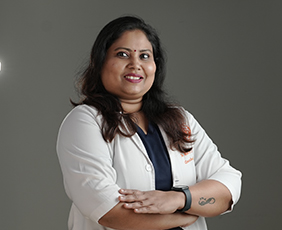


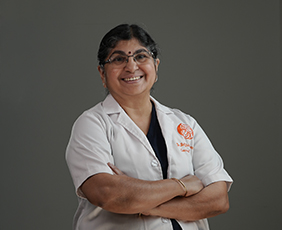

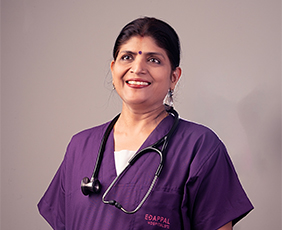
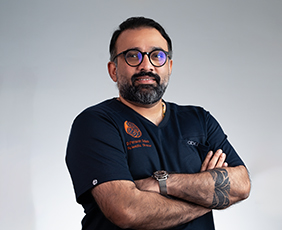
Dr. Parasuram Gopinath
(OBG)
Medical Director & Scientific Director
Cimar the Women’s Hospital
Book An Appointment
